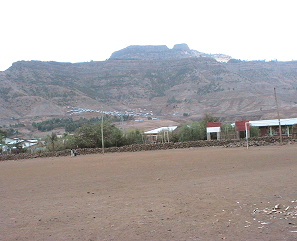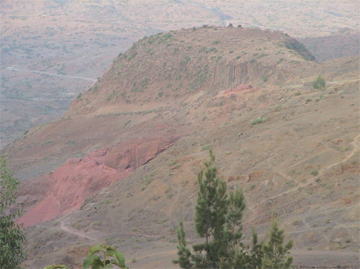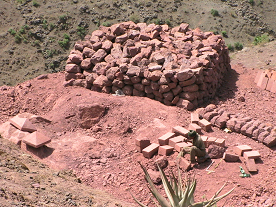 Editors'
note: The following is a personal geologic travelogue recounting a recent trip
to Lalibela, Ethiopia.
Editors'
note: The following is a personal geologic travelogue recounting a recent trip
to Lalibela, Ethiopia.
The mysteries of Lalibela,
Ethiopia
Tsegaye Hailu
Visiting and getting around Ethiopia
 Editors'
note: The following is a personal geologic travelogue recounting a recent trip
to Lalibela, Ethiopia.
Editors'
note: The following is a personal geologic travelogue recounting a recent trip
to Lalibela, Ethiopia.
Our plane left Bahir Dar, Ethiopia, at about 11:20 AM on May 26, and 30 minutes later we landed at the Lalibela airport. My family of four and one European passenger were the only visitors to disembark that day. Apparently, it was not yet the tourist season.
Lalibela is located close to the top of a volcanic plateau in northern Ethiopia. The site is home to 11 churches that were carved out of the rocks in the 12th century. All photos courtesy of Tsegaye Hailu.
The European passenger turned out to be a high school teacher in Addis Ababa, the capital of Ethiopia. He told me that it was his eighth year arranging a tour of Lalibela for his graduating class, who would be arriving the next day. "Young Ethiopians should visit this place when they finish high school and before they scatter to wherever life takes them," he told me. I had missed that opportunity by more than four decades, but found it is never too late to visit this place that many people call the Eighth Wonder of the World.
Although I grew up in Ethiopia, I have to admit that I had no notion of the fascinating architectural accomplishments of Lalibela. Eleven churches were intricately sculpted out of rock and interconnected by a series of tunnels and trenches. Some of the structures are free standing, connected to the bedrock only at the base, while others have only one or two faces freed from the parent rock. As elaborate as the outside carving is, the inside of these churches is even more intricately sculpted into domes, arches and other shapes. Unlike many other wonders of the world that are no longer standing, Lalibela is as alive and active a place of worship as it had been when it was built in the 12th century.
 King Lalibela
chose this area, then called Roha, to build these edifices partially because
of the geology. The region is naturally fortified with towering mountains of
flood basalts of Middle Tertiary age (30 million years) and deep canyons that
have been cut into them through erosion. Fortification was necessary, as over
many millennia, religious battles had taken their toll on Ethiopian churches.
King Lalibela
chose this area, then called Roha, to build these edifices partially because
of the geology. The region is naturally fortified with towering mountains of
flood basalts of Middle Tertiary age (30 million years) and deep canyons that
have been cut into them through erosion. Fortification was necessary, as over
many millennia, religious battles had taken their toll on Ethiopian churches.
The St. George church, pictured here, is one of the most famous of Lalibela, which is a World Heritage Site.
The tradition of carving churches from bedrock had begun much earlier in the north of the country. There, the structures, such as the 10th-century Abraha Atsbeha church west of Wukro, are sculpted out of red sandstone of Mesozoic age (about 200 million years ago) that underlies the Tertiary volcanics. Naturally, I assumed that the rock used in Lalibela was also this same sandstone. All of the pictures that I had seen had depicted a rock that looked like sandstone in color and texture. I became more and more intrigued as my observations on the ground did not fit my preconceived ideas, which were challenged as soon as we landed.
The airport nearest Lalibela lies in a wide-open valley whose sides eventually rise to towering volcanic mountains. This spot marks the headwaters of the Tekeze River, one of the major tributaries to the Nile River. The 20-kilometer paved road to the town of Lalibela follows the valley upstream for some distance before turning west. As our shuttle drove us into town, I kept expecting the road to go down in elevation into some canyon where I knew the red sandstone is to be found. However, the road simply kept rising across the layer after layer of lava flows until suddenly we were there, in Lalibela.
 I gave up my
geologic thoughts during the process of checking into the Lal Hotel. But that
afternoon, when we were walking around the outside of the first structure, the
Medhane Alem church, I started wondering about the geology again. I saw a dark-colored
rock on the floor of the trench that surrounds the church, and I guessed that
this must be a dike. I followed it briefly, expecting to see it cut through
what I still assumed was the red sandstone that formed the walls of the trench,
but I could not see where it went. I didn't want to miss Terekbe's (our tour
guide) lecture on the history of the majestic Medhane Alem, the first and largest
of the churches to be built, so I put off my queries again and followed him.
As we went from church to church I kept seeing "dike" rocks here and
there. However, having failed to see a dike cutting across the red rock, I simply
assumed that the dark rocks must be sills.
I gave up my
geologic thoughts during the process of checking into the Lal Hotel. But that
afternoon, when we were walking around the outside of the first structure, the
Medhane Alem church, I started wondering about the geology again. I saw a dark-colored
rock on the floor of the trench that surrounds the church, and I guessed that
this must be a dike. I followed it briefly, expecting to see it cut through
what I still assumed was the red sandstone that formed the walls of the trench,
but I could not see where it went. I didn't want to miss Terekbe's (our tour
guide) lecture on the history of the majestic Medhane Alem, the first and largest
of the churches to be built, so I put off my queries again and followed him.
As we went from church to church I kept seeing "dike" rocks here and
there. However, having failed to see a dike cutting across the red rock, I simply
assumed that the dark rocks must be sills.
This outcrop of bright red volcanic tuff stands out against the backdrop of black basalts and lighter-colored sandstone. The view is from the the Lal Hotel in the town of Lalibela.
After the afternoon tour, I was relaxing outside our hotel, which overlooked a narrow and steep-sided valley on its south side, when I noticed a block of bright red rock that was apparently being quarried. No other red rock was visible on the sides of the valley. This piqued my interest: I wanted to examine this outcrop of red rock.
The next morning, when we found out that our flight to Axum would be delayed by three hours, I got the chance. Terekbe agreed to accompany me to the quarry site after finishing the tour of the second group of churches. We followed a road cut into the side of the valley that exposed a band of red soil that had been baked by a lava flow. At the end of this flow, the basalt formed nearly perfect, eight-sided columnar joints.
 The red rock
I had observed from the hotel lay below the road. Quarry workers were excavating
unweathered parts of the red rock from the base of the outcrop and turning it
into beautifully cut building stones. Some of these stones were made into perfect
pyramidal shapes for gate posts. Studying the unweathered rock chips, I realized
that this was not the sedimentary rock that I had assumed before, but instead
volcanic tuff, which is relatively easy to carve like sandstone. I walked around
the block of red quarry rock and saw a clear contact line between it and the
surrounding basalt. The red tuff was simply floating in a sea of basalt like
a cork.
The red rock
I had observed from the hotel lay below the road. Quarry workers were excavating
unweathered parts of the red rock from the base of the outcrop and turning it
into beautifully cut building stones. Some of these stones were made into perfect
pyramidal shapes for gate posts. Studying the unweathered rock chips, I realized
that this was not the sedimentary rock that I had assumed before, but instead
volcanic tuff, which is relatively easy to carve like sandstone. I walked around
the block of red quarry rock and saw a clear contact line between it and the
surrounding basalt. The red tuff was simply floating in a sea of basalt like
a cork.
This view shows that the red volcanic rocks shown above were actually being quarried and turned into beautifully cut building stones for Lalibela's churches.
Terekbe and I went back up the hill to a vantage point from which we could view the site of St. George church (a cross-shaped structure and one of the most famous sites at Lalibela) from across the Yordanos (Jordan) River. It was clear from this view that the red tuff into which the church was carved rests on basalt just as the quarry block does.
To my surprise, the limited search I did on the Internet for published geologic reports of Lalibela turned up nothing at all. Nonetheless, the ancient people who carved the churches clearly knew the difference between the easily workable tuff and the hard basalt. At the Medhane Alem church, they stopped digging after they hit the hard basalt floor.
The entire block of red volcanic tuff that all the Lalibela churches were hewn from is unique from the rest of the dark-colored basalt lavas that dominate the area. There is no significant stratigraphic continuity in any direction outside of the curved blocks. Hopefully, others will study this unique aspect and publish the geologic history of Lalibela to complement that of its astounding human accomplishments.
|
Ethiopian Airlines, British Airways and Lufthansa fly from the United States to Addis Ababa, Ethiopia. All domestic flights are operated by Ethiopian Airlines. Lalibela is about a two-hour flight from Addis Ababa and flights are scheduled everyday. It's probably best to contact a travel agent for details on where to stay and how to get around. A travel agent or a simple Internet search will also lead you to a plethora of tour package options, which can be a good option, as they frequently combine Lalibela with other, equally fascinating, historic as well scenic sites in Ethiopia, Hailu says. Visiting Lalibela during the rainy season — from June to September — is virtually impossible due to the terrain. Try to plan a visit between September/October and May. Some highly celebrated Ethiopian Orthodox church holiday dates to plan around include: September 27, when the churches throughout Ethiopia celebrate the Finding of the True Cross; Epiphany on January 19; and Easter in April. Lalibela will be crowded with pilgrims and visitors on these dates. The towns in red on this map of Ethiopia indicate historically important locations, including Lalibela. Map courtesy of Tsegaye Hailu. The government of Ethiopia requires that international visitors have a visa (in addition to a passport) to enter the country. Visas may be obtained through the Ethiopian Embassy. Yellow fever immunization is recommended. |
Links:
Ethiopian
Embassy
U.S.
State Department information on Ethiopia
Lalibela
tourism Web site
Absolute
Africa's tours of Ethiopia
 |
Geotimes Home | AGI Home | Information Services | Geoscience Education | Public Policy | Programs | Publications | Careers |